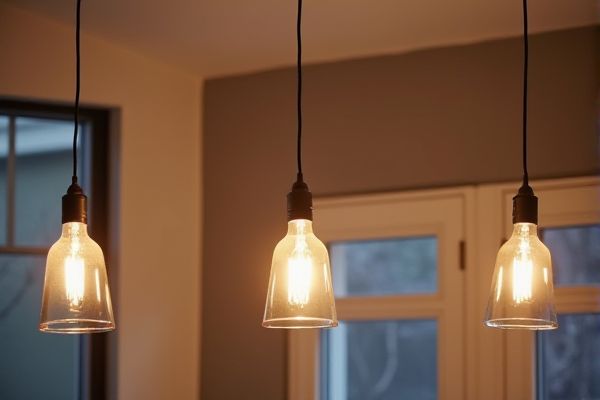
Pendant lights create a focal point with their decorative designs and provide targeted illumination, enhancing the ambiance of kitchens or dining areas, while recessed lighting offers a sleek, unobtrusive look by being embedded in the ceiling and delivering even, ambient light throughout a room. Explore this article to understand which lighting option best suits Your space and style preferences.
Table of Comparison
| Feature | Pendant Lights | Recessed Lighting |
|---|---|---|
| Installation | Surface-mounted, hangs from ceiling | Installed flush into ceiling |
| Design | Decorative, focal point | Minimalist, discreet |
| Light Direction | Downward or ambient | Wide or focused beam |
| Ceiling Type | Works with standard ceilings | Requires ceiling cavity |
| Maintenance | Easier bulb replacement | Can be harder to access |
| Energy Efficiency | Depends on bulb choice | Often compatible with LED |
| Cost | Moderate to high | Moderate to high, includes installation |
| Use Cases | Task lighting, decor | Ambient, general lighting |
Introduction to Pendant Lights and Recessed Lighting
Pendant lights provide focused illumination while serving as decorative elements, making them ideal for kitchen islands, dining areas, and entryways. Recessed lighting offers a sleek, unobtrusive solution that evenly distributes ambient light, perfect for low ceilings or minimalist designs. Choosing between pendant lights and recessed lighting depends on your space requirements, desired aesthetic, and functional needs.
Design Aesthetics and Visual Appeal
Pendant lights create a striking focal point with their varied shapes, materials, and colors, enhancing Your space's design aesthetics through both form and function. Recessed lighting offers a sleek, minimalist look by blending seamlessly into the ceiling, providing subtle illumination without competing for attention. Both options influence visual appeal differently: pendant lights add character and style, while recessed lighting emphasizes clean lines and modern simplicity.
Functional Differences and Practical Applications
Pendant lights provide focused illumination ideal for task areas such as kitchen islands and dining tables, creating visual interest and decorative appeal. Recessed lighting offers a sleek, unobtrusive solution that evenly distributes ambient light across a room, making it suitable for general lighting in living rooms, hallways, and offices. The choice depends on whether targeted, statement lighting or seamless, wide coverage is desired for the space.
Installation Process and Flexibility
Pendant lights require a straightforward installation process, typically involving mounting the fixture to an existing electrical junction box, allowing for easier updates or replacements. Recessed lighting demands more extensive installation, including cutting ceiling holes, wiring within ceiling cavities, and potentially reinforcing ceiling structures to accommodate housing units. Pendant lights offer greater flexibility in adjusting height and placement, while recessed lighting provides a sleek, built-in appearance with limited adjustability once installed.
Space Requirements and Ceiling Height Considerations
Pendant lights require sufficient ceiling height and space to hang freely without obstructing movement or sightlines, making them ideal for rooms with higher ceilings and open floor plans. Recessed lighting fits flush within the ceiling, conserving headroom and providing a sleek look, especially beneficial in rooms with lower ceilings or limited space. Your choice depends on ceiling height and spatial constraints, ensuring the lighting complements the room's scale and function.
Lighting Quality and Ambiance Creation
Pendant lights offer focused, directional lighting ideal for task areas, creating a warm and inviting ambiance with decorative appeal. Recessed lighting provides even, diffuse illumination that enhances room brightness without visible fixtures, fostering a clean, modern atmosphere. Combining both types can balance functional lighting quality with versatile ambiance effects in various interior spaces.
Cost Comparison: Upfront and Long-Term
Pendant lights typically have a lower upfront cost, ranging from $50 to $300 per fixture, while recessed lighting fixtures cost between $100 and $250 each, excluding installation. Installation for recessed lighting is more expensive due to ceiling modifications, averaging $125 to $250 per light, whereas pendant lights often require simpler wiring at around $65 to $100 per fixture. Long-term energy costs depend on bulb type, with LED options offering efficiency and savings for both, but maintenance for recessed lighting can be higher due to accessibility challenges.
Energy Efficiency and Maintenance
Pendant lights and recessed lighting differ significantly in energy efficiency and maintenance requirements. Pendant lights often use energy-efficient LED bulbs but may consume more power depending on the fixture size and number of bulbs, while recessed lighting, especially when equipped with LED chips, tends to offer superior energy savings due to its integrated design and directional focus. Your choice impacts maintenance efforts; pendant lights require more frequent cleaning and bulb replacements due to exposed fixtures, whereas recessed lighting stays cleaner and requires less upkeep since the lights are embedded within ceilings.
Suitability for Different Room Types
Pendant lights provide targeted illumination ideal for dining areas, kitchen islands, and entryways where visual focus is needed, enhancing both style and function. Recessed lighting suits living rooms, hallways, and bathrooms by offering a clean, unobtrusive look with even light distribution that doesn't disrupt room aesthetics. Your choice depends on whether you prefer statement fixtures for focal points or subtle lighting that blends seamlessly with the ceiling.
Final Verdict: Choosing the Right Lighting Option
Pendant lights create focal points and add decorative appeal, ideal for kitchens and dining areas where ambiance matters. Recessed lighting offers a sleek, unobtrusive option providing even illumination, perfect for minimalist designs or low ceilings. Your choice depends on whether you prioritize aesthetic impact with pendant lights or seamless, functional lighting with recessed fixtures.
 homyna.com
homyna.com